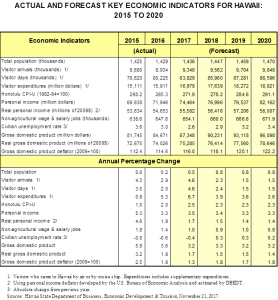DBEDT News Release: DBEDT PREDICTS STABLE ECONOMIC GROWTH
Posted on Nov 22, 2017 in Latest Department News, MainHONOLULU – The Department of Business, Economic Development and Tourism (DBEDT) released its fourth quarter 2017 Statistical and Economic Report, which shows that the overall economic condition of Hawaii remains stable into the next few years and economic growth will be steady, around 1.5 percent.
During the first 10 months of 2017, the tourism industry has been performing better than expected. Visitor arrivals increased 4.9 percent and visitor spending increased 7.1 percent during the first nine months this year. According to the daily passenger data published by DBEDT, October’s passenger count increased 4.2 percent, which indicates the October visitor count will be an increase. For the first 20 days of November, passenger count increased 5.7 percent. In terms of visitor arrivals, it is on track towards another record level of visitors this year.
“We are happy to learn that scheduled air seats, the supply side of the tourism industry, will increase by 8.5 percent during the first three quarters of 2018,” said DBEDT Director Luis P. Salaveria. “Based on the current trend, there is the potential that we may be welcoming more than 9.5 million visitors in 2018.”
“It is a positive sign that direct flights to the neighbor islands during the next three quarters is expected to increase by more than 20 percent,” explained State Economist Dr. Eugene Tian. “That will help to ease the inter-island flight shortage due to Island Air ceasing operations on November 10.”
The labor market condition in Hawaii has been one of the best in the nation in the last few years. In October 2017, unemployment rate registered a record low rate of 2.2 percent, seasonally adjusted rate, and was the lowest rate in the nation for October. Year-to-date, Hawaii’s unemployment rate ranked the third lowest in terms of seasonally adjusted rate and ranked the lowest in terms of not seasonally adjusted rate.
Through October, the state gained 7,800 additional payroll jobs as compared with the same period last year. The increase in jobs mostly occurred in tourism-related industries. Retail trade and food services each added 2,500 jobs during the first 10 months, and accommodations added 1,100 hotel jobs, however, there are a few industries which lost jobs. Wholesale trade lost 600 jobs, financial activities and government sectors each lost 500 jobs, manufacturing and construction each lost 400 jobs during the first 10 months of the year.
There were 12,850 people looking for jobs in October, the lowest level since January 2007. During the first 10 months of 2017, average labor force and employment reached historic record high levels.
The value of private building permits increased 2.8 percent during the first nine months of 2017. The value of residential permits increased 14.7 percent, commercial and industrial permit values increased 119.4 percent, and value of additions and alterations decreased by 22.6 percent. The increase in building permit values will be reflected in construction activities next year.
The most recent economic forecast for the U.S. and the world indicates that most of the economies of the world, especially those our visitors are coming from, will experience continued economic growth in 2017 and 2018. The U.S. economy is expected to grow by 2.2 percent in 2017 and 2.5 percent in 2018, both are higher than the growth rate of 2016.
DBEDT revised the visitor industry forecast upward again with visitor arrivals now growing at 4.6 percent for 2017, 2.3 percent for 2018 and 1.5 percent for 2019 and 2020. Visitor expenditures will be at 6.7 percent for 2017, 3.9 percent for 2018, and 3.6 percent for 2019 and 2020.
DBEDT revised its projection of Hawaii’s economic growth, as measured by the real gross domestic product (GDP), upward from the third quarter projection to 1.7 percent for 2017, 1.5 percent for both 2018 and 2019, and 1.4 percent for 2020.
“The overall economic condition is good. We have one of the best labor markets in the nation, tourism is performing well, our real estate market continues to be strong, and more building permits are being issued,” said State Economist Dr. Eugene Tian. “The challenge is that not all the industries are performing well, some industries continue to lose jobs.”
DBEDT kept its projection on non-farm payroll job count unchanged at 1.0 percent in 2017 and falling to 0.8 percent in 2020. The unemployment rate projection now is lower for 2017 at 2.6 percent and will gradually increase to 3.4 percent by 2020.
DBEDT kept the nominal personal income growth rates unchanged from the previous quarter forecast in the neighborhood of 3.3 and 3.5 percent. Real personal income projections were also kept the same as the previous quarter forecast at rates below 2 percent for the next few years.
DBEDT kept its projections for the Honolulu consumer inflation rates unchanged from the forecast in the previous quarter at 2.5 percent for 2017, and 2.3 percent for the outer years. Consumer inflation rate for Honolulu during the first half of 2017 was 2.5 percent.
The DBEDT Quarterly Statistical and Economic Report contains more than 120 tables of the most recent quarterly data on Hawaii’s economy as well as narrative explanations of the trends in these data.
The full report is available at: dbedt.hawaii.gov/economic/qser/.
# # #
